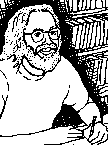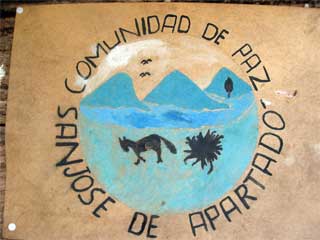
 Law of Justice and Peace
Law of Justice and Peace
by Marc Becker
For Colombia Support Network newsletter Action on Colombia
Polo Democrático leader Clara López succinctly defined the Law of Justice and Peace in the last issue of this newsletter as a “controversial legislation [that] offers reduced sentences of a maximum of 8 years to paramilitary commanders in exchange for full confessions and reparation of victims.” To say that it is controversial is a bit of an understatement, as deep divisions run through Colombian society in terms of the intent and usefulness of this law that president Álvaro Uribe promulgated two years ago.
As perhaps with most issues in Colombia, opinions over the law cannot easily be broken into two opposing camps. Nevertheless, in talking to a wide variety of Colombians in March 2007, two dramatically polarized perspectives (with significant variations) on the legislation emerged.
Jenny Claudia Almeida, a lawyer with the justice and peace section of the attorney general’s office in Bogotá, painted a picture of a 40-year conflict in Colombia as a result of drug trafficking, with the paramilitary forming as a conservative reaction to left-wing guerrillas. The Law of Justice and Peace was Uribe’s attempt to find a political solution to the country’s conflict. Almeida emphasized that the law comes out of the will of the paramilitary to accept the law. Their punishment is relatively light, but in exchange they must leave their armed group, come completely clean on their actions, and turn over their property. The attorney general’s office is constructing a massive database to document and verify paramilitary actions, and to cross check stories. Investigating these cases was like taking the lid off of a pot, as increasingly more information came out. Almeida was very professional but also passionately committed to her work, stating that she was personally tired of death and violence and that the compromises of this law were worth it to bring peace to Colombia.
Luis Jairo Ramírez, Executive Director of the Permanent Committee for the Defense of Human Rights (CPDH), painted an almost polar opposite depiction of this law. Rather than rooting Colombia’s conflict in drug trafficking which he noted is a recent phenomenon, Ramírez traced the violence back to the Spanish conquest 500 years ago. A new cycle of conflict emerged in the 1940s (long before the emergence of drug trafficking in the 1970s and 1980s) with a consolidation of the dominate culture that excluded popular sectors, leading to the emergence of guerrilla groups to defend peasant interests. Paramilitaries emerged in the 1960s not as a third armed actor, but as an integral part of state structures. Financed by drug trafficking, land owners, elite economic interests, and multinational corporations, the paramilitaries engaged in a dirty war. Paramilitary leaders claimed that they would disappear when the guerrillas did, but the recent history of guerrilla demobilization with the paramilitaries still in action casts doubt that this was ever the objective. Rather, paramilitary actions led to an extreme concentration of land ownership that in reality was a reverse agrarian reform. Furthermore, the paramilitary goal was to liquidate civilian opposition, with a particular genocidal focus on union leaders. Ramírez painted the Law of Justice and Peace as a sham, as a law of impunity, as an amnesty to forgive crimes without requiring any serious punishment, reparations, or structural changes. Furthermore, it was a misnomer to label this a peace process because peace is negotiated between adversaries and not among friends, as was the case with Uribe and the paramilitary that never attacked his government or economic interests. Ramírez called for a true peace agreement not so that everything stays the same, but so that things change.
Broadly, most people we met with could be grouped in one of these two groups, but often with significant twists on the law.
Antioquia’s human rights director Rocío Pineda emphasized that her province had been at the forefront of the war, and now with this law it was taking a leading role in bringing peace to the country. Her sympathies with the conservative Uribe presidency were clear, and she seemed to be positioned to whitewash the crimes of the paramilitary violence. Lt. Colonel Hector Miguel Cruz Rocha of the National Police in Apartado proclaimed the effectiveness of the law, and noted that the only problem was demobilized paramilitaries who turned to common criminal activities. In contrast, Apartado mayor José Phidalgo Banquero Zapata acknowledged intrafraternal violence among paramilitary groups, but claimed that the principal source of lingering problems were guerrillas who had not demobilized. Colonel Jorge Arturo Salgado Restrepo, second in command of the 17th army brigade in Apartado, however, painted Colombia as living in a post-conflict period in which the guerrillas had been defeated.
Those with a sophisticated view of Colombian history, including Colonel Salgado, acknowledged previous problems but emphasized the importance of the military’s human rights work and success in pressing for a more integrated approach to working with rural communities. Similarly, Ministry of Defense Viceminister Sergio Jaramillo urged people to let the justice system do its work. From his point of view, the Law of Justice and Peace was not perfect but the government was going in the right direction and with time things would improve.
In contrast, lawyers at the Corporación Libertad y Justicia strongly criticized the Justice and Peace Law for ignoring the rights of victims and providing no mechanisms for reparations or confessions. Paramilitary leaders often only acknowledge acts of complicity by military soldiers who are already dead, and continue to maintain that their victims were guerrillas. The demobilization is a sham; the structures are the same but only the name of the organization has changed to Aguilas Negras. In contrast, the lawyers have launched a campaign to accompany victims of the violence and to bring truth to light. They call their campaign “Memories against silence and impunity: Never again crimes of the state.” These lawyers see the military’s human rights language as pure rhetoric, nothing more. If there appears to be a drop in homicides it is not because this law is working, but rather than when the paramilitary gain hegemony in a region they commit fewer crimes in order to project an image of peace and harmony.
Birgit Gerstenberg from the United Nations High Commission for Human Rights reports that “The right to life was affected by the persistence of murders, with the characteristics of extrajudicial executions, attributed to members of the security forces, particularly the army.” The number of human rights violations increased from 2005 to 2006, with Indigenous and Afro-Colombian communities, social leaders, human rights defenders, peasants, women, children, labor union members, journalists, and displaced persons particularly affected. “High levels of impunity persist,” she reports. Gerstenberg acknowledged that NGOs were not very confident in the attorney general’s office to solve these problems, and she also noted failings and shortcomings of the Law of Justice and Peace. They are dealing with more than 10,000 cases, which is perhaps ten times the number that they can handle. Nevertheless, she personally expressed faith in the attorney general’s office to pursue this process, even though it will take a long time. Truth, Gerstenberg said, is the most important goal.
But is Truth sufficient to overcome centuries of conflict? What will it take to bring peace to Colombia?
Rwanda, site in 1994 of one of the worst genocides in human history, has largely moved beyond artificial colonial divisions into Hutu and Tutsi ethnic populations that fueled the bloody conflict. Similar to Rwanda, Sami Rasouli from the Muslim Peacemaker Teams suggests that previously Iraqis did not have strong Sunni or Shiite ethnic identities, but that imperial interests created those identities in order to stir up a civil war. Re-creating a unified Iraqi identity would help bring healing to the land. Can the Law of Justice and Peace, as conservatives in Colombia hope, similarly bring peace to that country?
Arguably, to suggest so is to misunderstand fundamental differences between the conflicts. Rather than an ethnic conflict, Colombia is torn by long patterns of social, political, and economic exclusion. Or, rather, class conflicts become racialized as white elites use repressive apparatuses such as police, military, and paramilitary forces to subjugate marginalized peasant, Indigenous, and Afro-Colombian peoples. Simply creating a unified ‘Colombian’ national identity would fail to address these underlying exclusionary systems of domination.
When the high level of criminal activity in Rwanda overwhelmed the courts’ ability to process the cases, the country turned to traditional justice systems (gacaca courts). Likewise, as Gerstenberg notes, paramilitary activities vastly exceed the Colombian judicial system’s ability to prosecute the crimes. Furthermore, as López noted in the last issue of this newsletter, paramilitary leader Salvatore Mancuso has not confessed even 5 percent of his criminal activities. Unlike Rwanda, however, Colombia does not have an alternative traditional justice system that could help with the backlog. In the face of this reality, the Law of Justice and Peace becomes increasingly ineffective.
For activists who hold dear such concepts as peace, justice, and human rights, the language of this law and its adherents is particularly onerous as it exploits language of the left to reinforce the exclusionary and exploitative agenda of elite conservatives. Rather than applauding the law as an avenue to peace, solidarity activists need to work to reveal it for the sham that it is.
Marc Becker is a Latin American historian and active with Community Action on Latin America (CALA) in Madison, Wisconsin. He was a participant in a March 2007 CSN delegation to San José de Apartado.